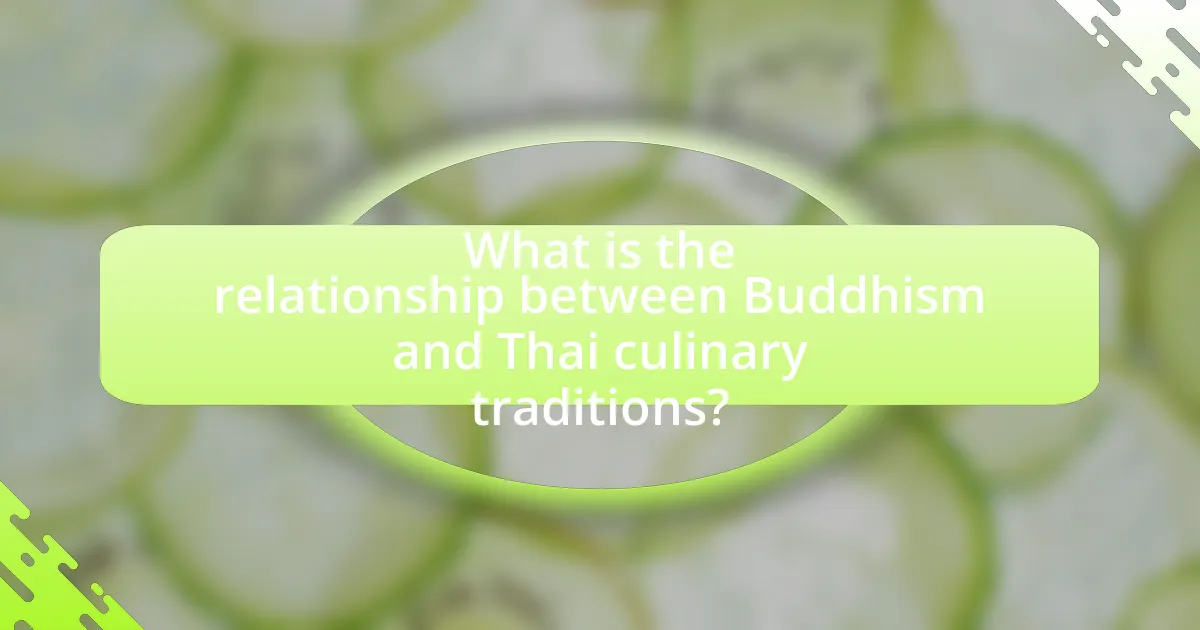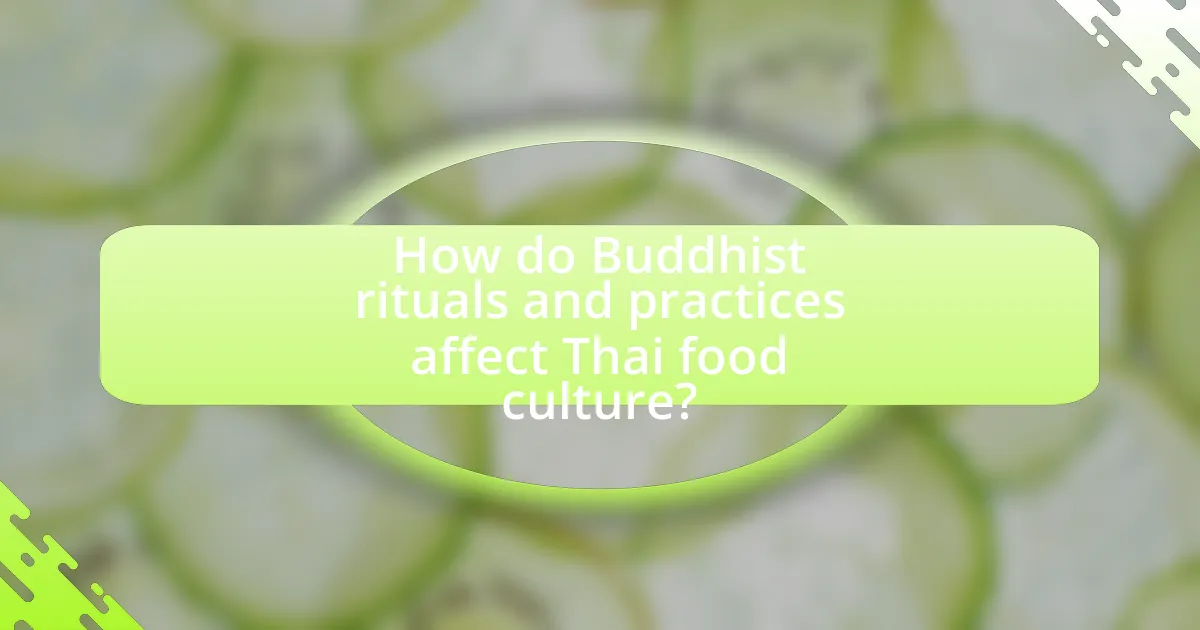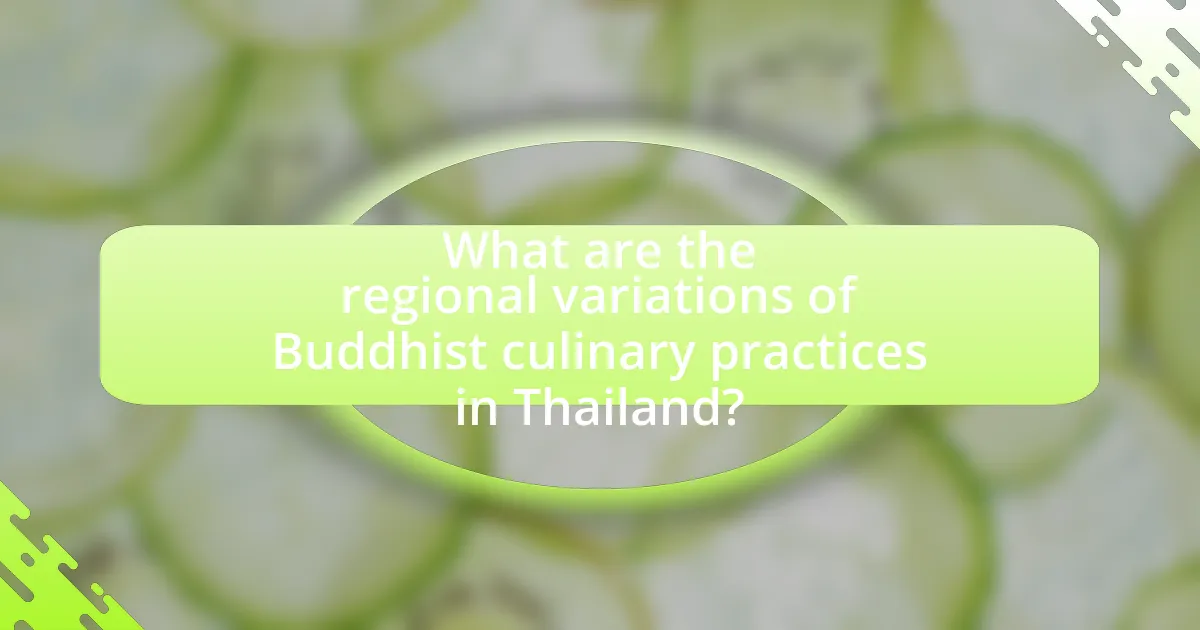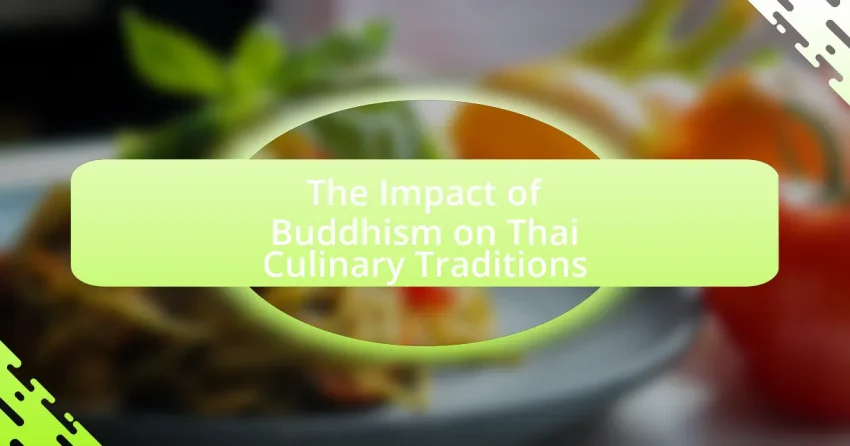The article examines the profound influence of Buddhism on Thai culinary traditions, highlighting the promotion of vegetarianism and mindful eating practices rooted in Buddhist principles such as ahimsa, or non-violence. It discusses how Buddhist rituals, festivals, and the practice of almsgiving shape dietary customs and food preparation methods in Thailand, leading to a rich variety of vegetarian dishes. Additionally, the article explores regional variations in Buddhist culinary practices, contemporary challenges posed by globalization, and efforts to preserve traditional Buddhist food heritage, providing practical tips for incorporating Buddhist principles into everyday cooking.

What is the relationship between Buddhism and Thai culinary traditions?
Buddhism significantly influences Thai culinary traditions by promoting vegetarianism and mindful eating practices. Many Thai Buddhists observe vegetarian diets during specific religious periods, such as the annual Vegetarian Festival, which emphasizes the consumption of plant-based foods and abstaining from meat. This practice stems from the Buddhist principle of ahimsa, or non-violence, which encourages compassion towards all living beings. Additionally, Buddhist rituals often incorporate food offerings to monks, reinforcing the cultural importance of food in spiritual practices. These elements collectively shape the culinary landscape in Thailand, highlighting the deep connection between Buddhism and local food customs.
How has Buddhism influenced the development of Thai cuisine?
Buddhism has significantly influenced the development of Thai cuisine by promoting vegetarianism and the use of fresh, natural ingredients. The Buddhist practice of non-violence towards living beings has led to a cultural preference for plant-based dishes, especially during religious observances such as Lent, when many Thai Buddhists abstain from meat. This has resulted in a rich variety of vegetarian options in Thai cuisine, including dishes like pad thai and green curry made with tofu and vegetables. Additionally, the emphasis on balance and harmony in Buddhist philosophy has shaped the flavor profiles and presentation of Thai food, encouraging the use of contrasting tastes such as sweet, sour, salty, and spicy.
What are the key Buddhist principles that shape Thai culinary practices?
Key Buddhist principles that shape Thai culinary practices include mindfulness, non-violence, and the concept of merit-making. Mindfulness in cooking emphasizes the importance of being present and intentional in food preparation, which enhances the overall dining experience. Non-violence, or ahimsa, influences the preference for vegetarianism among many Thai Buddhists, as it promotes compassion towards all living beings. The practice of merit-making is reflected in the tradition of offering food to monks, which is believed to generate good karma. These principles collectively guide the ethical and spiritual dimensions of Thai cuisine, reinforcing a connection between food, culture, and Buddhist values.
How do Buddhist festivals impact food preparation and consumption in Thailand?
Buddhist festivals significantly influence food preparation and consumption in Thailand by promoting vegetarianism and the offering of alms. During major festivals like Vesak and Makha Bucha, many Thai Buddhists adhere to a vegetarian diet, which leads to increased demand for plant-based dishes and the preparation of specific foods that align with religious practices. For instance, during these festivals, families prepare traditional vegetarian meals, often featuring ingredients like tofu, vegetables, and rice, to honor the Buddha and merit-making rituals. Additionally, the practice of giving alms to monks during these festivals involves preparing and offering food, which reinforces communal ties and the sharing of meals among families and communities. This cultural emphasis on food as a means of spiritual merit and community bonding underscores the integral role of Buddhist festivals in shaping culinary practices in Thailand.
What role does vegetarianism play in Thai Buddhist cuisine?
Vegetarianism plays a significant role in Thai Buddhist cuisine as it aligns with the Buddhist principle of ahimsa, or non-violence towards all living beings. This dietary practice is particularly observed during important Buddhist festivals, such as the annual Vegetarian Festival, where adherents abstain from meat and animal products to purify the body and mind. The Thai Buddhist community often incorporates a variety of plant-based ingredients, such as vegetables, fruits, and grains, into their meals, reflecting a commitment to compassion and mindfulness in food choices. This adherence to vegetarianism is not only a spiritual practice but also influences the broader culinary landscape in Thailand, promoting a diverse array of vegetarian dishes that are integral to Thai culture.
Why do many Thai Buddhists adopt a vegetarian diet?
Many Thai Buddhists adopt a vegetarian diet primarily to adhere to the principle of non-violence, or ahimsa, which is central to Buddhist teachings. This commitment to non-violence extends to all living beings, leading many practitioners to avoid consuming meat as a way to minimize harm. Additionally, during certain religious observances, such as Uposatha days, Thai Buddhists are encouraged to follow a vegetarian diet to purify the mind and body. The practice is also supported by cultural traditions that emphasize compassion and mindfulness in daily life, reinforcing the ethical and spiritual motivations behind vegetarianism in the Thai Buddhist community.
What are the most popular vegetarian dishes in Thai cuisine influenced by Buddhism?
The most popular vegetarian dishes in Thai cuisine influenced by Buddhism include Pad Thai Jay, Green Curry with Tofu, and Som Tum (Papaya Salad). Pad Thai Jay is a vegetarian version of the classic stir-fried noodle dish, made with tofu and vegetables, reflecting the Buddhist principle of non-violence towards animals. Green Curry with Tofu substitutes meat with tofu and a variety of vegetables, showcasing the use of fresh ingredients in Buddhist cooking. Som Tum, a spicy salad made from green papaya, is often prepared without fish sauce to adhere to vegetarian practices. These dishes exemplify the integration of Buddhist values into Thai culinary traditions, emphasizing plant-based ingredients and ethical eating.

How do Buddhist rituals and practices affect Thai food culture?
Buddhist rituals and practices significantly influence Thai food culture by shaping dietary customs and food preparation methods. For instance, the practice of merit-making involves offering food to monks, which emphasizes the importance of vegetarianism and the use of fresh, local ingredients in daily meals. Additionally, during Buddhist holy days, such as Uposatha, many Thai people abstain from meat, leading to a rise in vegetarian dishes and plant-based cuisine. This connection between spirituality and food is evident in traditional dishes like Khao Niew Mamuang (mango sticky rice), which are often prepared for religious ceremonies. The integration of these practices into everyday life reinforces the cultural significance of food as a means of expressing respect and devotion within the Buddhist framework.
What are the common rituals associated with food in Thai Buddhism?
Common rituals associated with food in Thai Buddhism include almsgiving, merit-making, and the practice of vegetarianism during certain religious observances. Almsgiving involves laypeople offering food to monks, which is a significant act of merit and reinforces the monastic community’s sustenance. Merit-making is often linked to food offerings at temples, where devotees present food to Buddha images or monks as a way to accumulate good karma. Additionally, during specific periods like the Buddhist Lent, many Thai Buddhists adopt vegetarianism, reflecting the principle of non-harm and compassion towards all living beings. These practices are rooted in Buddhist teachings and are integral to the cultural and spiritual life in Thailand.
How do these rituals influence the types of food prepared for offerings?
Buddhist rituals significantly influence the types of food prepared for offerings by emphasizing vegetarianism and the use of specific ingredients that align with Buddhist principles. These rituals often require offerings to be made from fresh, wholesome foods, such as fruits, vegetables, and rice, which reflect the values of compassion and non-violence inherent in Buddhism. For instance, during important ceremonies like almsgiving, laypeople prepare meals that avoid meat and strong flavors, adhering to the monks’ dietary restrictions. This practice not only supports the monks’ spiritual journey but also reinforces the community’s commitment to ethical eating, as seen in the widespread use of plant-based dishes in Thai Buddhist culture.
What significance do communal meals hold in Buddhist practices?
Communal meals in Buddhist practices hold significant importance as they foster a sense of community and promote mindfulness. These shared meals, often referred to as “sangha meals,” are integral to monastic life, where monks and laypeople come together to share food, reinforcing social bonds and mutual support. The act of eating together is also a practice of mindfulness, encouraging participants to appreciate the food and the effort that went into its preparation, aligning with the Buddhist principles of gratitude and awareness. Additionally, communal meals serve as a means of merit-making, where sharing food with others is believed to generate positive karma, thus enhancing spiritual growth.
How do monks and monasteries contribute to Thai culinary traditions?
Monks and monasteries significantly contribute to Thai culinary traditions by promoting vegetarianism and the use of local, seasonal ingredients. Monastic dietary practices emphasize simplicity and mindfulness, leading to the creation of dishes that are both nutritious and reflective of Buddhist principles. For instance, the practice of almsgiving encourages the community to provide food to monks, which often includes rice, vegetables, and fruits, thereby influencing local agricultural practices and food availability. Additionally, many traditional Thai dishes, such as curries and soups, have roots in monastic cooking, where the focus is on balance and harmony in flavors, aligning with the Buddhist philosophy of moderation.
What types of food are typically prepared in monasteries?
Monasteries typically prepare vegetarian meals, focusing on simple, wholesome ingredients. These meals often include rice, vegetables, legumes, and fruits, reflecting Buddhist principles of non-violence and mindfulness in food preparation. Monastic cuisine emphasizes fresh, seasonal produce and may incorporate traditional Thai flavors, such as herbs and spices, while avoiding meat and strong flavors to maintain a sense of purity and simplicity in line with Buddhist teachings.
How does the practice of almsgiving shape food culture in Thailand?
The practice of almsgiving significantly shapes food culture in Thailand by fostering a communal spirit and influencing dietary habits. Almsgiving, or “tak bat,” involves monks receiving food offerings from laypeople, which cultivates a sense of generosity and gratitude within the community. This ritual not only reinforces the Buddhist principle of merit-making but also impacts the types of food prepared and consumed, as offerings often include rice, fruits, and traditional dishes that reflect local agricultural practices. Consequently, the emphasis on fresh, seasonal ingredients in Thai cuisine is partly a result of this practice, as families strive to provide quality offerings to monks, thereby intertwining religious observance with culinary traditions.

What are the regional variations of Buddhist culinary practices in Thailand?
Buddhist culinary practices in Thailand exhibit significant regional variations influenced by local ingredients, cultural traditions, and interpretations of Buddhist dietary guidelines. In central Thailand, vegetarian dishes are common, particularly during Buddhist Lent, with a focus on rice, vegetables, and tofu. In contrast, northern Thailand incorporates more herbs and spices, reflecting the region’s unique agricultural products, and often features dishes like khao soi, which may include meat but is prepared with a mindful approach to consumption. Southern Thailand emphasizes seafood and coconut-based dishes, aligning with the coastal geography, while still adhering to Buddhist principles by avoiding certain meats on holy days. These variations illustrate how local customs and resources shape the expression of Buddhist dietary practices across different regions of Thailand.
How do different regions of Thailand interpret Buddhist dietary laws?
Different regions of Thailand interpret Buddhist dietary laws with varying degrees of strictness and adaptation to local customs. In central Thailand, particularly in Bangkok, many Buddhists adhere to a vegetarian diet during specific religious observances, such as Uposatha days, reflecting a commitment to non-violence and compassion. In contrast, northern Thailand incorporates more meat into its cuisine, with local interpretations allowing for the consumption of certain meats, especially during festivals and communal gatherings, while still respecting the core principles of Buddhism. Southern Thailand often blends Buddhist dietary practices with Islamic influences, leading to a unique culinary landscape where seafood is prevalent, and vegetarian options are available but not as strictly followed. These regional variations highlight how local culture and traditions shape the interpretation of Buddhist dietary laws, demonstrating a balance between religious adherence and cultural identity.
What unique dishes are associated with Buddhist celebrations in various regions?
Unique dishes associated with Buddhist celebrations in various regions include vegetarian offerings such as “Jae” in Thailand, which consists of plant-based dishes prepared during the Buddhist Lent, and “Buddha’s Delight” in China, a stir-fried vegetable dish often served during the Lunar New Year. In Japan, “Shojin Ryori” is a traditional vegetarian cuisine served during Buddhist festivals, emphasizing seasonal ingredients and simplicity. These dishes reflect the Buddhist principles of non-violence and mindfulness, as they are often prepared with care and respect for the ingredients.
How does local culture influence the integration of Buddhism in regional cuisines?
Local culture significantly influences the integration of Buddhism in regional cuisines by shaping dietary practices and food preparation methods. In Thailand, for example, Buddhist principles emphasize vegetarianism and the avoidance of meat on certain days, which has led to the development of a rich variety of plant-based dishes that reflect local ingredients and flavors. This cultural adaptation is evident in the widespread use of herbs, vegetables, and rice in Thai cuisine, aligning with Buddhist teachings on mindfulness and compassion towards all living beings. Additionally, local festivals and rituals often incorporate Buddhist practices, further embedding these dietary customs into the culinary landscape, as seen in the preparation of specific dishes during Buddhist holidays that honor the teachings of the Buddha.
What are the contemporary challenges facing Buddhist culinary traditions in Thailand?
Contemporary challenges facing Buddhist culinary traditions in Thailand include the influence of globalization, which has led to the commercialization of food practices, and the decline in the number of monks who traditionally uphold these culinary customs. Globalization has introduced fast food and Western dietary habits, diminishing the emphasis on vegetarianism and mindful eating that are central to Buddhist teachings. Additionally, the reduction in monastic communities has resulted in fewer individuals practicing and passing down traditional recipes and cooking methods, threatening the preservation of these culinary traditions. According to a study by the Food and Agriculture Organization, the shift towards convenience foods has significantly altered dietary patterns in Thailand, impacting the cultural significance of Buddhist cuisine.
How is globalization affecting traditional Buddhist food practices?
Globalization is influencing traditional Buddhist food practices by introducing diverse culinary elements and altering dietary habits. As global food networks expand, traditional Buddhist diets, which often emphasize vegetarianism and local ingredients, are increasingly incorporating international flavors and fast food options. This shift is evident in urban areas of Thailand, where convenience and global food trends challenge the adherence to traditional practices. Studies indicate that younger generations are more inclined to adopt these globalized food choices, leading to a decline in the consumption of traditional Buddhist meals that prioritize simplicity and mindfulness.
What efforts are being made to preserve Buddhist culinary heritage in Thailand?
Efforts to preserve Buddhist culinary heritage in Thailand include the establishment of culinary schools that focus on traditional vegetarian recipes, the promotion of local ingredients used in Buddhist cooking, and the organization of food festivals celebrating Buddhist cuisine. For instance, the Thai government and various NGOs have initiated programs to educate chefs and the public about the significance of vegetarianism in Buddhism, emphasizing the use of seasonal and organic produce. Additionally, temples often host cooking classes and workshops that teach traditional Buddhist recipes, ensuring that these culinary practices are passed down through generations. These initiatives are supported by cultural preservation policies aimed at maintaining Thailand’s rich culinary traditions linked to Buddhism.
What practical tips can be applied to incorporate Buddhist principles into everyday cooking?
To incorporate Buddhist principles into everyday cooking, focus on mindfulness, simplicity, and compassion. Mindfulness can be practiced by being fully present during the cooking process, paying attention to the ingredients, and appreciating their origins. Simplicity involves using fresh, seasonal ingredients and minimizing waste, aligning with the Buddhist value of non-attachment. Compassion is reflected in cooking for others, ensuring meals are nourishing and considerate of dietary restrictions. These practices not only enhance the cooking experience but also resonate with the core Buddhist teachings of awareness, moderation, and kindness.
